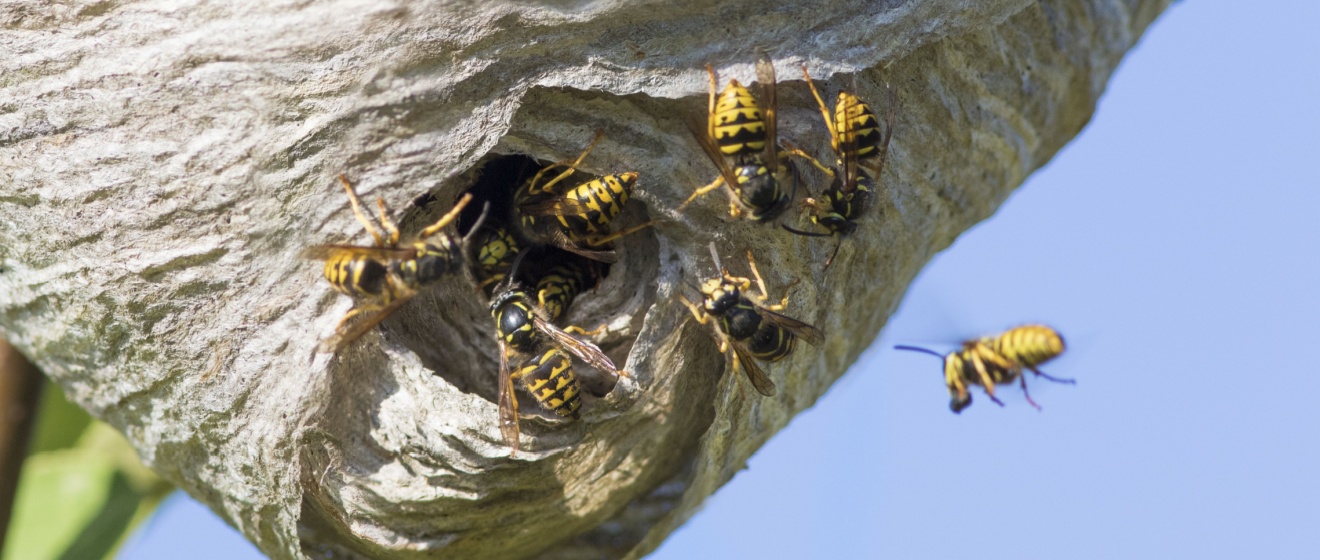Chapel Hill’s warm climate and lush landscapes make it a beautiful place to live—but they also make it an ideal environment for stinging insects. As summer winds down and fall approaches, many homeowners begin to notice increased insect activity around their homes. Wasps, yellow jackets, hornets, and even some types of bees become especially aggressive this time of year as they defend their nests and search for food.
Spotting a nest early—and knowing how to respond—can protect your family, pets, and visitors from painful stings and potentially dangerous allergic reactions. At Scott’s Turf & Pest Services, we’ve helped countless Chapel Hill residents identify and safely eliminate stinging insects. Here’s how to recognize the warning signs and what steps to take if you discover a nest on your property.
Common Types of Stinging Insects in Chapel Hill
Before you can identify a nest, it helps to know what types of stinging insects are most common in our area:
- Yellow Jackets: Known for their aggressive behavior, yellow jackets typically build underground nests or nests in wall voids and attics.
- Paper Wasps: These wasps construct open, umbrella-shaped nests under eaves, in sheds, or inside outdoor furniture.
- Bald-Faced Hornets: A type of aerial yellow jacket, they build large, enclosed paper nests in trees, on structures, or under overhangs.
- Carpenter Bees: Though less aggressive, they bore holes into wood structures and can weaken decking and trim over time.
Each species behaves a little differently, but they all have one thing in common—they will sting to protect their colony.
Signs You May Have a Nest Nearby
How can you tell if stinging insects are nesting on your property? Here are several signs Chapel Hill homeowners should watch for:
One of the first and most obvious signs is a noticeable increase in wasp or hornet traffic in a specific area. If you see multiple insects flying in and out of the same spot (like a hole in the ground or a gap in siding), that’s a likely sign of a nearby nest.
Some nests are easy to spot, such as the paper nests built by hornets or paper wasps. These may hang from eaves, trees, or porch ceilings. Yellow jacket nests are usually hidden underground or inside walls but may occasionally become visible if disturbed.
If you hear a low, constant buzzing sound near your home—especially around walls, attics, or rooflines—it may indicate an active nest hidden within the structure.
Carpenter bees create smooth, round holes in wood to lay their eggs. If you notice tiny holes accompanied by sawdust, you may be dealing with these less aggressive (but still painful) stinging insects.
Why Nest Removal Isn’t a DIY Job
It may be tempting to try to knock down a nest with a broom or spray it with over-the-counter chemicals, but that approach is risky. Most stinging insects will defend their nest with surprising aggression, and multiple stings can result in serious health issues—especially for those with allergies.
Professional pest control is the safest and most effective way to handle a nest. At Scott’s Turf & Pest Services, we have the tools, training, and protective equipment to remove nests without putting your family at risk. We also identify how the insects got in and help prevent future infestations.
What to Do If You Find a Nest
If you suspect you have a stinging insect nest, follow these steps:
Don’t approach or disturb the nest. Sudden movements or vibrations can trigger an attack from defensive insects.
If possible, block off the area to keep children and pets away until professionals arrive. Place a visible marker near the site for your pest control technician.
3. Avoid Strong Scents and Bright Colors
While waiting for professional help, avoid using strong perfumes, brightly colored clothing, or floral patterns near the nest, as these can attract wasps and bees.
Contact Scott’s Turf & Pest Services as soon as possible. We’ll schedule a prompt inspection and create a custom treatment plan to safely eliminate the problem.
Long-Term Prevention Tips
Once the nest is removed, consider these strategies to reduce the chances of stinging insects returning:
- Seal cracks and gaps in siding, vents, and rooflines.
- Keep outdoor trash cans tightly sealed and clean.
- Cover food and drinks during outdoor meals.
- Regularly inspect eaves, sheds, and playground equipment.
- Schedule seasonal pest control services from Scott’s Turf & Pest Services to stay ahead of infestations.
Trust the Local Experts in Chapel Hill
If you’ve noticed increased insect activity or suspect a nest on your property, don’t wait for a sting to take action. At Scott’s Turf & Pest Services, we specialize in the safe removal and prevention of stinging insects throughout Chapel Hill and surrounding areas.
We offer fast, friendly, and affordable pest control with a commitment to protecting your family, pets, and property. Whether it’s a yellow jacket colony underground or a wasp nest in your eaves, we’ve got the experience and tools to handle it safely and effectively.
Ready to schedule your inspection? Visit Scott’s Turf & Pest Services today.

